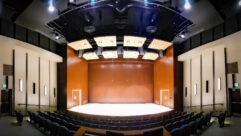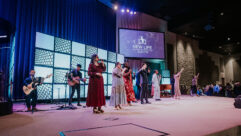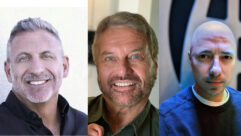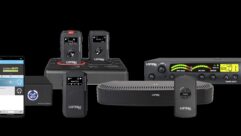On this edition of the SVC Podcast, Contributing Editor Bennett Liles talks with Mike Cook, Audio Manager for the Carolina Opry at the Calvin Gilmore Theatre in Myrtle Beach. Mike describes their return to production after the flooding of Hurricane Florence and he outlines the installation of the new RCF sound system to provide vocal clarity for the wide range of performances hosted there. Mike also covers the RDNet software used for monitoring and control.
Links of Interest:
· Carolina Opry – Calvin Gilmore Theatre
· Shure UHF-R Series wireless mics
· RCF RDNet network control software
This is the SVC Podcast from Sound & Video Contractor with Mike Cook of the Carolina Opry. We’ve got all the show notes and product links for the podcasts at svconline.com. Go to Podcasts at the top of the page.
A hurricane, a flood and a new RCF house sound system. The Calvin Gilmore Theatre in Myrtle Beach recently survived the first two and installed the third. Now their Carolina Opry and a wide range of other shows has what they need to energize an audience. Audio Manager Mike Cook has the story coming up next on the SVC Podcast.
Mike, I’m sure glad you could get together with us for the SVC Podcast from Myrtle Beach, South Carolina with everything that’s been going on weather-wise with both of us. You guys are just digging out and draining out so how are things in Myrtle Beach from Hurricane Florence and all that flooding?
Well, Bennett, I appreciate you asking me that. We’re doing really well. Luckily all the water levels have gone down and we got minimal damage, at least to the Opry. We have a lot of people that work there that had some issues. One in particular pretty much lost the bottom floor of his house, but everybody else came out unscathed. But there are a lot of people in this county right now that are still houses have water in them. But we’re just happy we didn’t get as much damage as we thought we were. The wind wasn’t the problem, it was basically the flooding. [Timestamp: 1:32]
Yeah.
But we’re open for business, though.
Well, that’s great. I’m in Atlanta and the area between us has been crisscrossed by two unusually powerful hurricanes in the past month so I think we’re both doing good to be here.
You’re exactly right, yeah. I feel for all the people in Florida and Georgia and everybody that was affected by the second one that came through – and unfortunately its name was Michael, which is mine, you know. [Laughs]
Oh well, it’ll take a while before they get back to that name again at least. Well, tell us about the Carolina Opry and the Calvin Gilmore Theater. It looks like that place has had a very rich past.
Yes it has. It started in 1986. We’re in our 33 year. It started in a little building that was actually a nightclub in Surfside Beach and it just kept growing and growing. Calvin built the current theater that we’re in, and it originally would seat 2,200. We actually updated seating, which dropped our seating capacity down to about 1,800 but the seats and stuff, they definitely made the patrons a lot happier because they rock. It’s kind of like being in a movie theater. But as far as shows and stuff, the Carolina Opry, which is basically a country and Top 40, I guess, and Broadway show was the mainstay for the theater for years. And about 10-12 years ago they decided to produce a 60’s, 70’s and 80’s show, which started out as Good Vibration, but now is named The Time Warp Show. So we have those two shows going on, plus we’ve added a magic show and we also have a TAL Show, which is called Thunder and Light, and it features the All That! Cloggers, which were runners up on several TV shows over the years. So they have a great show. We just finished out this morning; we did one of those. We do those about once a week. But we just want to make sure that people know we’re open for business. Everything is back up where we need to have it and I appreciate you asking. [Timestamp3:28]
Well, there are so many different kinds of shows going on in there from just speaking as with the magic shows, to the very elaborate productions that you can see. There are plenty of web videos and we’ll have links to some of those. The place has evolved since the original sound system was installed. Now you have a new RCF sound system so what type of sound setup did the Calvin Gilmore Theater have before and what sort of problems did you have with changes to the seating layout?
The original sound system, actually it was probably the third generation but it was in there the longest, was installed by Clair Brothers and we had a Clair R4 system. We chose boxes – we had an 18, a 12 and a two-inch throat in them. And we had 16 boxes in four hangs of four. And over the years holes developed in the room. There were just some dead spots. And with technology and the new line arrays we decided it was time after several past years of bringing in national acts and stuff, that it was time for us to change the sound system. The Clair rig worked great when it was first installed. It wasn’t that it wasn’t a good rig, it’s just outdated at that point in time so that was probably the main reason for us changing to the line arrays. Plus with the national acts, unfortunately a lot of them wouldn’t accept that, so I started to bring in RCF HDL 20 rig and flying them for .38 Special and a few of the bands we had in there that needed a little more SPL in the room. After the management heard that they decided that it was time for a change. I was glad to have that happen because it sure made it easier for me to mix the room. [Timestamp: 5:04]
Yeah, especially with both musical shows and purely spoken word acts in there, you’d have to have a system that’s pretty versatile. What was the preparation for that? You did pre-wiring and what did RCF do to support the installation project?
Well, timeframe as far as putting the system up was pretty condensed. I wanted to do it in a week. We had about 18 hours. So the pre-wiring, we came in and pulled all the CAT5 lines and stuff we needed for the RDNet. We pre-wired all the power that we needed to do and then RCF came in later, actually after the rig was up, Tarak came in with a – Terry Ewald – and listened to the rig and offered some suggestions. We’re an RCF house here at my business, MC Sound Consultants, and so I thought that was a natural box to go with. And especially with the RDNet out, that made total control from the booth possible, which is what I really needed in that house. And that’s the main reason we wanted the box, because it just sounded so good. It’s a vocal-forward box and we’re a vocal-heavy show, vocal-heavy venue. And it also sounds incredible with live music. The articulation of that box is just great. [Timestamp: 6:12]
The Calvin Gilmore Theater is a very elegant and classical style place with winding staircases and big hanging chandeliers. It would be easy for a new sound system to look out of place and clash with the architecture. Did you have to do any building modifications and who did the rigging for it?
The rigging was Stage Rigging Services, who’s owned by Les Martin. They’re out of Greensboro, North Carolina. We use them to do anything like that in the theater, lighting and that kind of stuff. Anything that has to do with curtains, they take care of all that. And there were no building modifications. The original points from the Clair rig, which was a whole lot heavier than what I’ve got in the air now [Laughs] were very sufficient. We were able to bridle across the points to put the speakers in a location that I need to have them to cover the room correctly. [Timestamp: 6:52]
And to get that whole system first installed and then tested I would think that you would have a very thin slice of time inserted into the heavy production schedule you’ve got.
Yes. Originally we were supposed to do it after the first of the year, and Calvin came in, who is the owner, and he came in and said, “You know something? I like the way the rig sounds when you bring yours in here. Let’s go ahead and do it now.” I said, “Calvin, we’ve got Christmas shows. We’ve got double shows a day. We just don’t have time. You’re talking about a week install.” He said, “You’ve got a Sunday to do it in.” So we literally started at 8:00 on Sunday morning and by 9:00 that night I actually had sound. What we did is while Les and his guys where – I’ll say “de-rigging”. I don’t know if that’s the correct term or not. They took down the old rig on one side. We flew one side and got it up and then we took the outside stack down on the opposite side and flew the other side of the line array. And they came back in the following Monday morning and in about an hour took the last four hangs, which weren’t really in our way. But that allowed me to come in Monday and finish tuning the room. Of course I’m one of those guys that I like to listen to something, then of course it’s a work in progress. My main concern down here is a lot of venues have this, especially at the beach, the humidity and barometric pressure and stuff and being in summer when it gets so hot, really change the quality of the system as far as the brilliance and stuff just because of the air getting thin and damp and the transmission between high frequencies are a little faster or a little slower. But the initial install really, all total, was about 18 hours, then I kind of tuned it as I went along. And after the first week we were pretty much where we needed to be as far as I was concerned. [Timestamp: 8:46]
I think a lot of the tuning was using the RDNet control software. They’ve got some very detailed tutorials and demos online and you can control not just EQ but amp fan speed and temperature. Part of their support was showing you all the features of the software. How much can you really do with it?
The RDNet is pretty much a complete controller. If you didn’t have any equalization in your console you could probably do everything from RDNet. An 8-band EQ, master EQ for each box. You can actually grab each individual box. You can turn each individual component off in the box – high frequency, low-frequency. You can see what’s going on with a box from the booth as well as the subs. And it has a inclinometer in it so you can actually see what the angles of the cabinet are. So when we got the boxes up we had the angels, at the bottom boxes, we could match them with the rigging. We used turnbuckles when we got it up so we were able to adjust that. And we were going to put motors up. We originally put motors up, but we decided to dead hang it because I can get to anything I need to in the system with a lift. But the RDNet is unbelievable. I love that the software is easy to use. The grouping and stuff. When I bring other bands in, .38 Special, they want to change something or if I bring in Kansas or some of the other bands that have been in there, they’re allowed to get in the software because we can save multiple pages of that for my show and for their show, and change delay times and stuff. But all that can be set up in the RDNet and it’s just very user-friendly. Then when Tarak came down from RCF, probably about three or four months afterwards, he actually showed me a few other features that I hadn’t seen yet. It’s kind of like a computer; you start digging in it and it has a basement in it and there’s other things you don’t ever get to if you don’t need them at that point in time. But they did a wonderful job of designing that software as far as being user-friendly. [Timestamp: 10:41]
I know that was fun watching one of those guys come in and turn up things on it that you didn’t even know it had. In Part 2 I want to get into the mixers and the stage monitoring. That’ll be interesting after having seen some of the videos from the show. Today we’ve been talking to Mike Cook, Audio Manager with the Carolina Opry at the Calvin Gilmore Theater in Myrtle Beach, South Carolina. It’ll be great to hear some more on this. Thanks for getting with us.
Hey, thank you, Bennett. Thank you for your time.
The Calvin Gilmore Theatre and all of its shows are underway again. We’ve got more behind the scenes details on the wireless mics, in-ear monitoring, the mixers and the acoustics coming up next week. Get with us for that on the next SVC Podcast.










